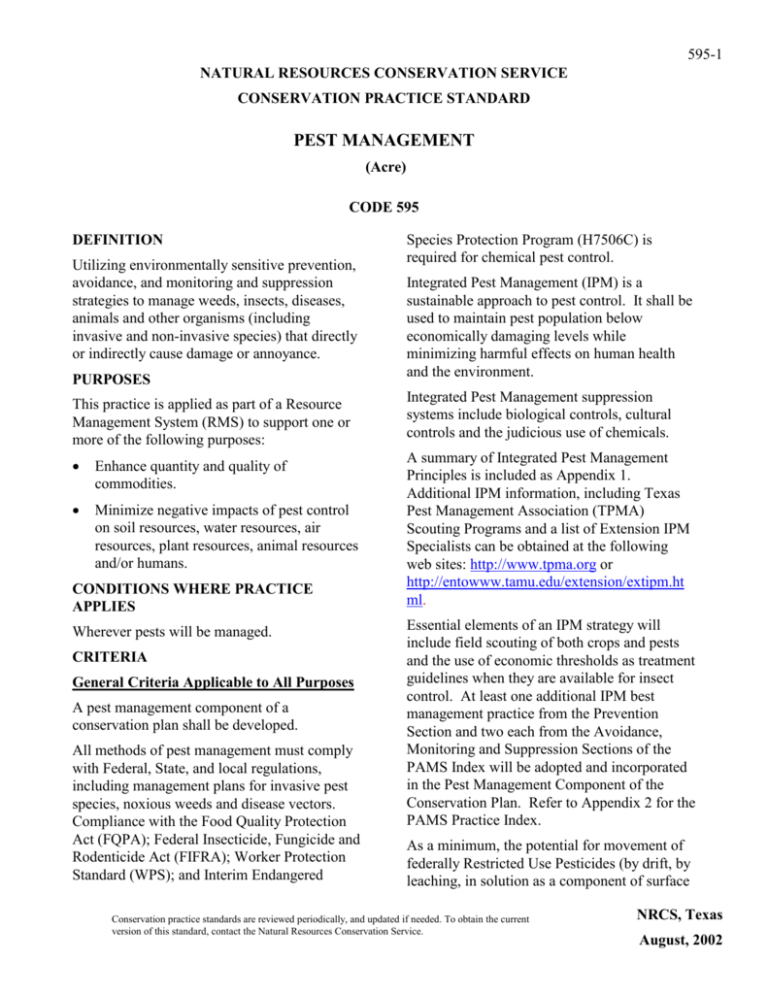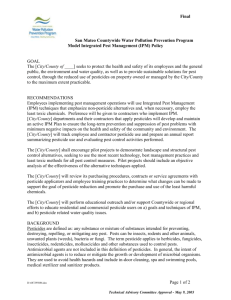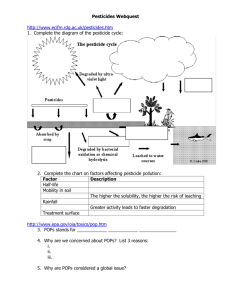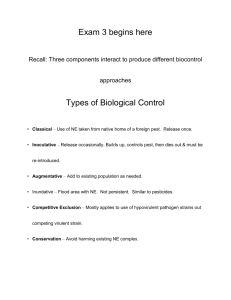NATURAL RESOURCES CONSERVATION SERVICE
advertisement

595-1 NATURAL RESOURCES CONSERVATION SERVICE CONSERVATION PRACTICE STANDARD PEST MANAGEMENT (Acre) CODE 595 DEFINITION Utilizing environmentally sensitive prevention, avoidance, and monitoring and suppression strategies to manage weeds, insects, diseases, animals and other organisms (including invasive and non-invasive species) that directly or indirectly cause damage or annoyance. PURPOSES Species Protection Program (H7506C) is required for chemical pest control. Integrated Pest Management (IPM) is a sustainable approach to pest control. It shall be used to maintain pest population below economically damaging levels while minimizing harmful effects on human health and the environment. This practice is applied as part of a Resource Management System (RMS) to support one or more of the following purposes: Integrated Pest Management suppression systems include biological controls, cultural controls and the judicious use of chemicals. Enhance quantity and quality of commodities. Minimize negative impacts of pest control on soil resources, water resources, air resources, plant resources, animal resources and/or humans. A summary of Integrated Pest Management Principles is included as Appendix 1. Additional IPM information, including Texas Pest Management Association (TPMA) Scouting Programs and a list of Extension IPM Specialists can be obtained at the following web sites: http://www.tpma.org or http://entowww.tamu.edu/extension/extipm.ht ml. CONDITIONS WHERE PRACTICE APPLIES Wherever pests will be managed. CRITERIA General Criteria Applicable to All Purposes A pest management component of a conservation plan shall be developed. All methods of pest management must comply with Federal, State, and local regulations, including management plans for invasive pest species, noxious weeds and disease vectors. Compliance with the Food Quality Protection Act (FQPA); Federal Insecticide, Fungicide and Rodenticide Act (FIFRA); Worker Protection Standard (WPS); and Interim Endangered Essential elements of an IPM strategy will include field scouting of both crops and pests and the use of economic thresholds as treatment guidelines when they are available for insect control. At least one additional IPM best management practice from the Prevention Section and two each from the Avoidance, Monitoring and Suppression Sections of the PAMS Index will be adopted and incorporated in the Pest Management Component of the Conservation Plan. Refer to Appendix 2 for the PAMS Practice Index. As a minimum, the potential for movement of federally Restricted Use Pesticides (by drift, by leaching, in solution as a component of surface Conservation practice standards are reviewed periodically, and updated if needed. To obtain the current version of this standard, contact the Natural Resources Conservation Service. NRCS, Texas August, 2002 595-2 runoff or adsorbed to eroding soil particles as a component of sediment) will be assessed based on a site evaluation. Identified concerns of pesticide movement will be addressed utilizing quality criteria located in Section III of the local NRCS Field Office Technical Guide. An appropriate set of conservation practices or management techniques will be implemented to minimize the movement of pesticides from the treatment zone. A partial list of conservation practices and management techniques that are known to be effective for reducing the negative impacts of pesticides are listed in Appendix 3. Additional practices are available in the NRCS Field Office Technical Guide and Texas Cooperative Extension Service Publications. to monitor soil erosion. Rating procedures such as the Soil Conditioning Index (SCI) will be used as needed to monitor soil quality. Pesticide label instructions will be followed to limit pesticide residues in soil that may negatively impact non-target plants, animals and humans. Additional Criteria to Protect Water Resources Pesticide related environmental risks, including the impacts of pesticides on surface and ground water resources on humans and non-target plants and animals must be evaluated for all identified water resource concerns. The pest management component must be integrated with other components of the conservation plan. The NRCS Windows Pesticide Screening Tool (WIN-PST) will be used to evaluate soil pesticide interactions in all fields where pesticides will be applied. Pesticide label instructions that identify environmental hazards, site specific application criteria and Texas Cooperative Extension recommendations must be followed. The WIN-PST program can be obtained at the following USDA web site: http://www.wcc.nrcs.usda.gov/water/quality/fra me/pestmgt.html Additional Criteria to Protect Quantity and Quality of Commodities Integrated Pest Management principles that include the combination of prevention, avoidance, monitoring and suppression strategies to maintain pests below economically damaging levels, minimize pest resistance and minimize the harmful effects of pest control on human health and environmental resources will be used. Additional Criteria to Protect Soil Resources In conjunction with other conservation practices, the number, sequence and timing of tillage operations shall be managed to maintain soil quality and maintain soil loss at or below the soil loss tolerance (T) or any other planned soil loss objective. Current erosion prediction tools such as (RUSLE), (WEQ) or similar tools will be used NRCS, Texas August, 2002 Priority will be given to those fields where Restricted Use Pesticides will be applied. EPA publishes a source list of these pesticides. It is entitled, "Restricted Use Products (RUP) Report", and can be obtained at the following web site: http://www.epa.gov/docs/RestProd/ Hazard Ratings are divided into five classes. These are: X - Extra High H - High I - Intermediate L - Low VL - Very Low 595-3 Hazard Ratings of Low or Very Low do not require any additional action as long as they are used according to the label and meet the quality criteria for a Resource Management System (RMS). Hazard Ratings of Extra High, High or Intermediate require mitigation measures to meet the quality criteria for a RMS. Extra High and High ratings require more extensive mitigation measures than Intermediate ratings. Mitigation measures may not be effective for Extra High hazard ratings if the resources are highly sensitive or a high degree of resource protection is desired. In these cases, an effective, economically acceptable pesticide with a lower risk or an alternate method of pest control may be required to meet quality criteria for a RMS. When a chosen alternative has significant potential to negatively impact important water resources, an appropriate set of mitigation practices and management techniques must be put in place to address risks to humans and non-target plants and wildlife. Pesticide alternatives with a WIN-PST “Extra High”, “High” or “Intermediate” shall be accompanied by one or more mitigating practices. When a rating of Extra High, High or Intermediate is obtained, mitigating practices will be added and evaluated until the Hazard Rating is reduced one rating level. Selection of mitigating practices and management techniques shall be based on sitespecific resource concerns and pesticide loss pathways. Appendix 3 contains a list of conservation practices that can help mitigate the adverse impacts of pesticides depending upon pesticide loss pathways. Effects are rated as slight (+/-), moderate (++/-) or significant (+++/---). loading and application setback distances for wells, streams, rivers, natural and impounded lakes and reservoirs. The number, sequence and timing of tillage operations shall be managed in conjunction with other sediment control tactics and practices, to minimize sediment losses to nearby surface water bodies. Additional Criteria to Protect Air Resources Pesticide label instructions to minimize volatilization and drift that may negatively impact non-target plants; animals and humans will be followed. Avoid spray drift by applying pesticides only when the wind speed does not exceed label restrictions or local, state or federal regulations and the wind direction is away from sensitive areas. Additional Criteria to Protect Plant Resources Special attention should be paid to pesticide label instructions including those that: Prevent misdirected pesticide applications that negatively impact non-target plants, animals and humans by following label instructions and remove pesticide residues from sprayers before moving to the next crop. When pesticide incorporation is recommended, incorporate to the depth specified on the label to minimize damage to non-target species. Pesticides will only be applied at the proper crop stage and under appropriate climatic conditions. Follow the recommended label rotational intervals to avoid injury to subsequent crops in the rotation. Follow pesticide label restrictions regarding soil texture, depth to water table and mixing, NRCS, Texas August, 2002 595-4 Encourage the use of systems that utilize the most appropriate means of pest management including cultural, biological and chemical methods. Use strategies such as pest scouting, soil testing and weather forecasting to help target suppression strategies, avoid routine preventative pest control and avoid unnecessary and poorly timed pesticide applications. Additional Criteria to Protect Humans The label instructions, as well as local, state and federal regulations that concern posting and field re-entry restrictions on treated areas will be followed. Base pesticide selection on characteristics such as water solubility, toxicity to nontarget organisms, degradation, adsorption, efficiency and cost. Plan erosion control practices to minimize soil loss and runoff that can transport absorbed or dissolved pesticides to surface waters. Soil pH, plant nutrients, soil moisture and soil condition will be managed to reduce plant stress, improve plant vigor and increase the plants overall ability to tolerate pests. Irrigation water should be managed to avoid conditions that are conducive to disease development and to minimize pest management environmental risks. Additional Criteria to Protect Animal Resources Special attention should be paid to pesticide label instructions in order to avoid injury to domestic animals, wildlife and aquatic organisms. All pesticides will be handled and properly applied in order to protect the user and the environment from adverse effects. Avoid unnecessary exposure to pesticides during mixing, handling and application by wearing protective clothing and using the equipment specified on the label. Pesticides will be stored according to label directions and as specified by local, state and federal regulations. All used pesticide containers will be rinsed and disposed of according to label directions and as specified by local, state and federal regulations. In case of accidental exposure, follow the instructions on the label. CONSIDERATIONS Use of a trained IPM professional to develop and implement the IPM strategy is strongly encouraged. When commodity-specific IPM is not available; the following IPM principles should be considered: NRCS, Texas August, 2002 PLANS AND SPECIFICATIONS The pest management component of a conservation plan shall be prepared in accordance with the criteria of this standard and shall describe the requirements for applying the practice to achieve its intended purpose(s). 595-5 As a minimum, the pest management component of a conservation plan shall include: A plan map and soil map of the managed site will be a part of the conservation plan. If applicable, use a location map to identify sensitive areas and setbacks. A summary of the IPM plan including: Crops to be grown and any anticipated pest problems. A field scouting plan and economic thresholds of anticipated pests (or a notation of the Texas Pest Management Association IPM Unit, independent private consultant or scouting service that will be performing these functions) A list of the additional IPM Management Practices that are planned for each field based on the PAMS Index. Select pesticides, which provide the desired crop protection and minimize the potential for surface and ground water contamination. An environmental risk analysis (WIN-PST Soil/Pesticide Interaction Loss Potential and Hazard Rating Report) for probable pest management recommendations will be utilized. The risk analysis will include Soil/Pesticide Interaction Screening Procedure 2 (SPISP2), ratings for Leaching Potential (ILP), Solution Runoff Potential (ISRP), Absorbed Runoff Potential (ISRP), and Human and Fish Ratings. OPERATION AND MAINTENANCE The producer is responsible for the proper implementation of this practice and this includes the operation and maintenance of all equipment. Operation and maintenance shall address the following: Plans shall be reviewed annually to incorporate new IPM technology, respond to cropping system and pest complex changes and avoid development of pest resistance. Maintain IPM practices and the practices that are needed to mitigate pesticide movement that are identified in the plan to ensure continued effectiveness. Develop a safety plan for individuals exposed to chemicals, including telephone numbers and addresses of emergency treatment centers for individuals exposed to chemicals and the telephone number for the nearest poison control center. The National Pesticide Telecommunications Network (NPTN) telephone number in Corvallis, Oregon may also be used in non-emergency cases by calling 1-800-424-7378, Monday through Saturday, between 6:30 AM to 4:30 PM Pacific Time. For advice and assistance with emergency spills that involve agrichemicals, the local emergency telephone number should be provided. The national 24-hour CHEMTREC telephone number is 1-800424-9300. Follow label requirements for mixing/loading setbacks from wells, intermittent streams and rivers, natural or impounded ponds and lakes, or reservoirs. Locate all pesticide mixing areas and storage and supply areas at least 150 feet away from any well or surface water body and down slope of wells. Never leave a spray tank unattended during filling. NRCS, Texas August, 2002 595-6 Prevent the contamination of water supplies by keeping the filler hose or pipe out of the spray tank at all times. Install an antisiphon device to prevent back flow. Pesticides used in chemigation shall be labeled for this method of application and all chemigation systems must be fitted with an anti-siphon device to prevent back flow. Post signs according to label directions and/or Federal, State, and local laws around sites that have been treated. Follow restricted entry intervals. Dispose of pesticides and pesticide containers in accordance with label directions and adhere to Federal, State, and local regulations. Read and follow label directions and maintain appropriate Material Safety Data Sheets (MSDS). Calibrate application equipment according to manufacturer recommendations before each seasonal use and with each major chemical change. NRCS, Texas August, 2002 Replace worn nozzle tips, cracked hoses, and faulty gauges. Each field should be individually monitored and written field scouting reports with field counts for pests should be maintained for at least two years. Pesticide application records will be developed and maintained in accordance with Texas Department of Agriculture guidelines. TDA Regulations and record keeping requirements may be found obtained at the following web site: http://www.agr.state.tx.us/pesticide/. 595-7 APPROVAL AND CERTIFICATION PEST MANAGEMENT (Acre) CODE 595 PRACTICE STANDARD APPROVED: ______/s/ Monty Dollar________ State Agronomist ___________8/1/02____________ Date This practice standard is needed in the __________________________ Field Office Technical Guide. ________________________________ District Conservationist __________________________ Date CERTIFICATION: Reviewed and determined adequate without need of revision. ________________________________ __________________________ Technical Specialist (Agronomy) ________________________________ Technical Specialist (Agronomy) Date __________________________ Date NRCS, Texas August, 2002








